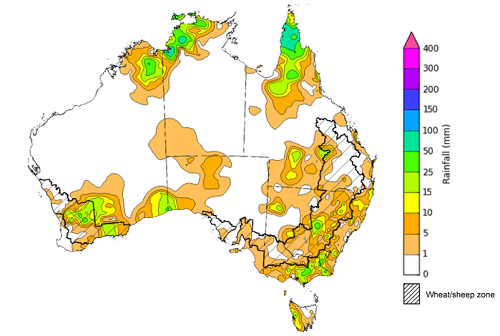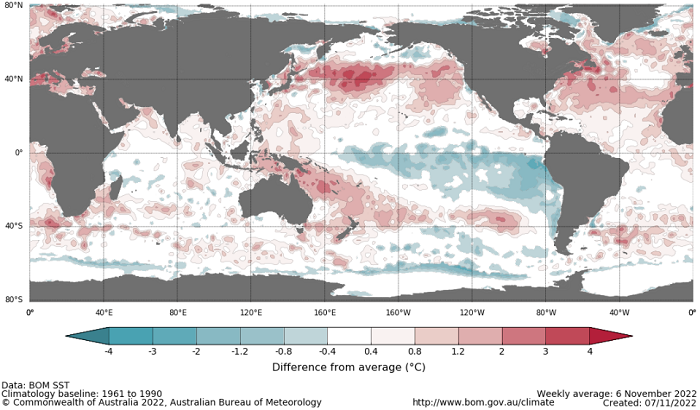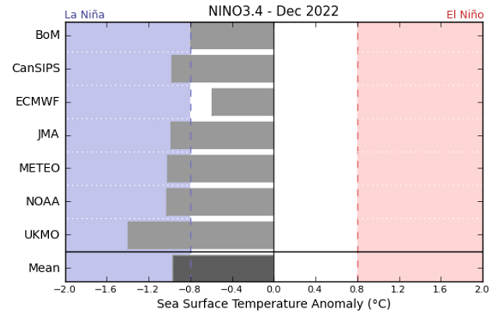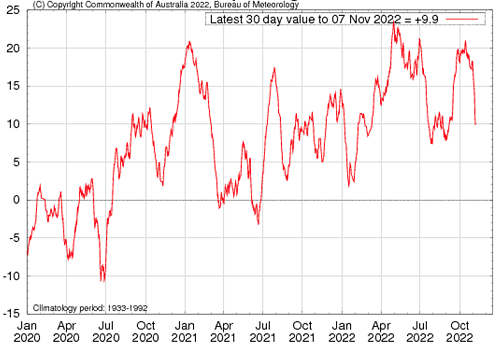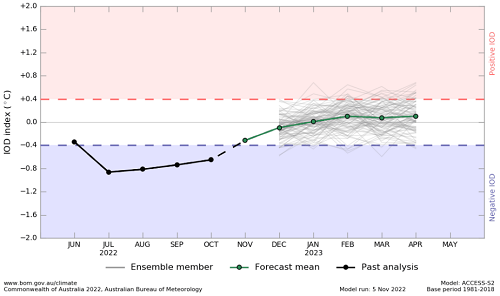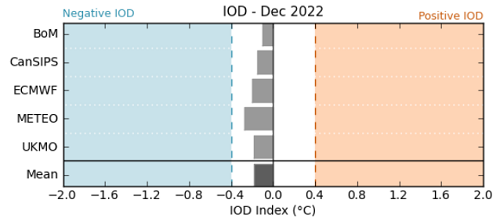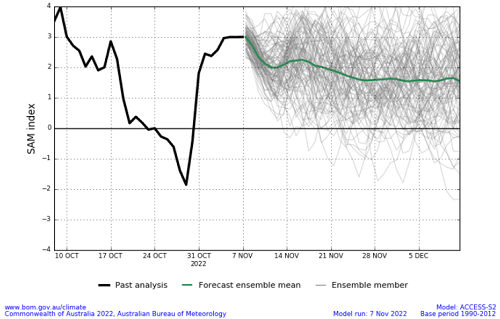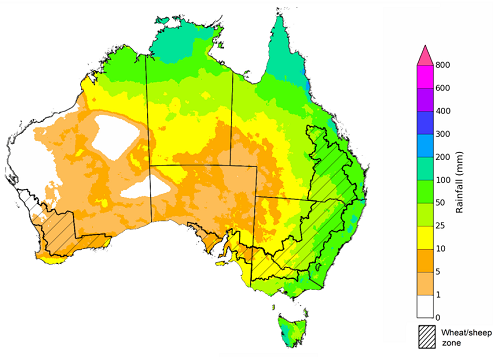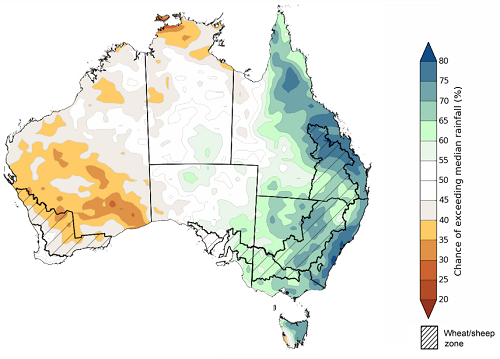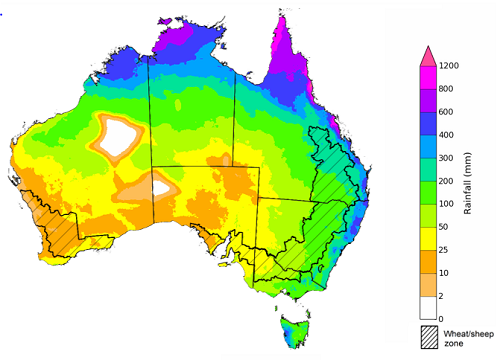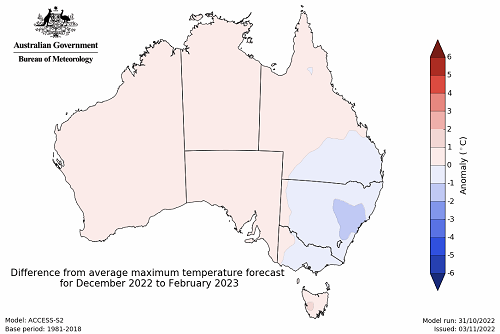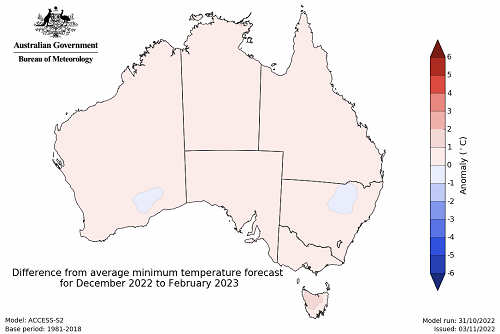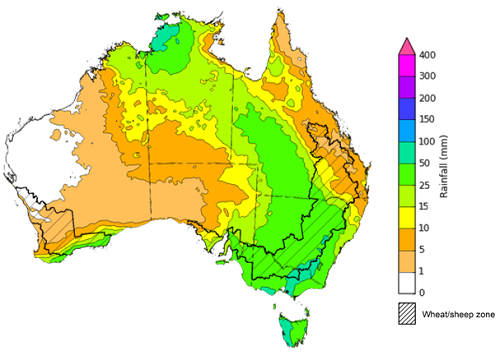Key issues
- For the week ending 9 November 2022, a high-pressure system in the south-east brought relatively dry conditions to much of Australia, with rainfall totals of less than 10 millimetres observed in most regions. Weekly rainfall totals exceeding 15 millimetres were observed in isolated parts of eastern Victoria, central and south-eastern New South Wales, southern parts of Western Australia, south-west South Australia, as well as northern parts of Western Australia, the Northern Territory, and Queensland.
- La Niña continues in the tropical Pacific, with atmospheric and oceanic indicators reflecting a mature La Niña event. The negative IOD event in the tropical Indian Ocean that has persisted since mid-June is currently declining and is expected to end in early December. The Southern Annular Mode is currently positive and is likely to remain positive into early summer. A Madden-Julian Oscillation of moderate strength is currently active over the western Pacific Ocean and is expected to move eastwards and weaken over the coming days.
- The rainfall outlook for December 2022 to February 2023 suggests there is a greater than 60% chance of exceeding median rainfall across most of Victoria, New South Wales, eastern Queensland, Tasmania, and eastern parts of South Australia. However, below median rainfall is likely for much of Western Australia and the northern tip of the Northern Territory between December to February.
- The temperature outlook for December 2022 to February 2023 indicates that maximum temperatures across most of Australia are likely to be close to average, with slightly lower than average maximum temperatures across eastern New South Wales. Minimum temperatures are expected to be slightly above average for part of north-east Tasmania, but close to average for the rest of Australia.
- Over the 8-days to 17 November 2022, a low-pressure system building over central Australia and moving south-east, is forecast to bring moderate rainfall to much of eastern and northern Australia. Meanwhile, a high-pressure system over the southern Indian Ocean is forecast to bring little to no rainfall to much of Western Australia, and western parts of South Australia.
- Water storage levels in the Murray-Darling Basin (MDB) decreased between 2 November 2022 and 9 November 2022 by 22 gigalitres (GL). Current volume of water held in storage is 24 147 GL which represents 96 per cent of total capacity. This is 8 percent or 1827 GL more than at the same time last year.
- Allocation prices in the Victorian Murray below the Barmah Choke decreased from $36 per ML on 28 October to $34 per ML on 4 November 2022. Prices are lower in the Goulburn-Broken, Murrumbidgee and regions above the Barmah choke due to the binding of the Goulburn intervalley trade limit, Murrumbidgee export limit and Barmah choke trade constrain.
Climate
For the week ending 9 November 2022, a high-pressure system in the south-east brought relatively dry conditions to much of Australia, with rainfall totals of less than 10 millimetres observed in most regions. Weekly rainfall totals exceeding 15 millimetres were observed in isolated parts of eastern Victoria, central and south-eastern New South Wales, southern parts of Western Australia, south-west South Australia, as well as northern parts of Western Australia, the Northern Territory, and Queensland.
In Australian cropping regions, rainfall totals of between 10 and 50 millimetres were recorded in isolated parts of central New South Wales, as well as central and southern parts of the Western Australian wheatbelt. Little to no rainfall was recorded in remaining cropping regions for the week ending 9 November 2022.
Heavy rainfall across eastern Australia during October maintained extremely high soil moisture levels, prohibiting access to fields for disease management, and interrupting the harvest of winter crops. The relatively drier conditions in eastern Australia over the past week will likely have given soils an opportunity to drain and improved access to fields for harvest and disease management.
Rainfall for the week ending 9 November 2022
Note: The rainfall analyses and associated maps utilise data contained in the Bureau of Meteorology climate database, the Australian Data Archive for Meteorology (ADAM). The analyses are initially produced automatically from real-time data with limited quality control. They are intended to provide a general overview of rainfall across Australia as quickly as possible after the observations are received. For further information go to http://www.bom.gov.au/climate/rainfall/
Throughout Australia’s late spring/early summer period the climate drivers with the largest potential impact on Australia’s climate patterns are the El Niño–Southern Oscillation (ENSO), the Indian Ocean Dipole (IOD), the Southern Annular Mode (SAM), and the Madden-Julian Oscillation (MJO). These climate drivers are likely to influence pasture growth across much of Australia, grain quality prospects and harvest conditions for winter crops, as well as the planting and establishment of summer crops.
La Niña continues in the tropical Pacific, with atmospheric and oceanic indicators reflecting a mature La Niña event. Cool sea surface temperature (SST) anomalies have persisted in the central and eastern equatorial Pacific Ocean in recent weeks, while warmer temperatures continue in the far-west of the Pacific, across the Maritime Continent, and to the north-east of Australia. Trade winds have been slightly stronger than average in the western Pacific and cloudiness has also remained below average around the Date Line, which reflect the ongoing La Niña event.
Current sea surface temperature gradient across the Indian Ocean continues to reflect the ongoing negative IOD event. The negative IOD event in the tropical Indian Ocean has persisted since mid-June is currently declining and is expected to end in early December.
The SAM is currently positive and is likely to remain positive into early summer. An MJO of moderate strength is currently active over the western Pacific Ocean and is expected to move eastwards and weaken over the coming days. Given current and expected conditions, including the La Niña event and the return to a positive SAM, above average rainfall is expected to persist across eastern Australia over the coming weeks.
Difference from average sea surface temperature observations 31 October to 6 November 2022
International climate model outlooks for the NINO 3.4 region in December 2022
Issued: 08/11/2021
The La Niña event currently underway in the Pacific Ocean is expected to persist through the end of 2022 but rapidly decay in early 2023. Six of the seven international models surveyed predict the La Niña event to remain active in December, but all models expect the La Niña event to dissipate by February 2023. For the period ending 6 November, the 30-day Southern Oscillation Index (SOI) value was +11.1 and the 90-day value for the period ending 6 November was +13.5, both of which are above the La Niña threshold of +7. La Niña events are associated with above average rainfall across eastern and northern Australia through spring and summer.
30-day Southern Oscillation Index (SOI) values ending 6 November 2021
The negative IOD event in the Indian Ocean that has persisted since mid-June is beginning to decline. As of 6 November 2022, the Indian Ocean Dipole (IOD) weekly index value was -0.33°C. This is the first time since mid-June that the IOD index value has not met the negative IOD threshold (−0.4°C). However, before the current negative IOD event can be considered finished, several weeks of consistently neutral IOD index values must be recorded. Furthermore, current weather patterns observed in the Indian Ocean remain characteristic of a negative IOD event.
Below average sea surface temperatures in the north-west of the Indian Ocean have dissipated over the past two weeks, with temperatures returning close to average. Warmer than average sea surface temperatures persist to the north-west of Australia but have decreased in intensity compared to two weeks ago. Warm sea surface temperatures in the east of the Indian Ocean tend to result in above average rainfall across southern Australia and the far north throughout spring. All international climate models surveyed by the Bureau of Meteorology predict the negative IOD event to persist throughout November, before declining rapidly by early summer.
Monthly sea surface temperature anomalies for IOD region
International climate model outlooks for the IOD in December 2022
Issued: 8/11/2022
The Southern Annular Mode (SAM) has returned to positive values and is expected to remain positive during early summer. The SAM refers to the north-south shift of the band of rain-bearing westerly winds and weather systems in the Southern Ocean compared to the usual position. A positive SAM in spring is associated with increased rainfall for parts of eastern New South Wales and Victoria as well as southern Queensland. It is also associated with decreased rainfall for parts of south-western and south-eastern Australia.
Southern Annular Mode (SAM) daily index
As of 6 November 2022 the Madden–Julian Oscillation (MJO) is at moderate strength over the western Pacific Ocean and is expected to weaken as it moves eastwards over the coming days. The MJO is a pulse of cloud and rainfall that moves eastward along the equator. An active MJO in the Pacific at this time of year increases the chance of above average rainfall over the eastern half of Australia.
Madden–Julian Oscillation (MJO) daily index
These climate outlooks are generated by ACCESS–S (Australian Community Climate Earth-System Simulator–Seasonal). ACCESS–S is the Bureau of Meteorology's dynamic (physics-based) weather and climate model used for monthly, seasonal, and longer-lead climate outlooks. For further information, go to http://www.bom.gov.au/climate/ahead/about/
The Bureau of Meteorology’s latest rainfall outlook for December indicates wetter than average conditions are expected across parts of Australia. The ACCESS-S climate model suggests there is a 60% to 80% chance of exceeding median rainfall for parts of eastern and northern Australia, with a 60% to 80% chance of below median rainfall for much of Western Australia.
The outlook for December 2022 indicates that there is a 75% chance of rainfall totals between 10 and 100 millimetres across much of New South Wales, Queensland, Victoria, the Northern Territory, and the northern tip of Western Australia. For most areas in South Australia and Western Australia rainfall totals are not expected to exceed 25 millimetres. Rainfall totals in excess of 100 millimetres are expected across northern parts of Queensland and the Northern Territory, as well as isolated parts of north-eastern New South Wales and western Tasmania.
Across cropping regions there is a 75% chance of rainfall totals of between 25 and 100 millimetres across much of New South Wales and Queensland, as well as isolated parts of eastern Victoria. There is a 75% chance of less than 25 millimetres of rainfall for cropping regions in Western Australia, South Australia, and much of Victoria, as well as the remaining cropping regions of New South Wales. Given above average to well above average soil moisture level across most growing regions in eastern Australia this forecast rainfall is unlikely to further benefit winter crop yields but will allow for average or better pasture growth potential. Given the current wet conditions and an expectation for above average rainfall for the coming months, we are likely to see a drawn-out 2022 winter crop harvest and a late start to summer crop planting in many regions.
Rainfall totals that have a 75% chance of occurring December 2022
Issued: 06/11/2022
The rainfall outlook for December 2022 to February 2023 suggests there is a greater than 60% chance of exceeding median rainfall across most of Victoria, New South Wales, eastern Queensland, Tasmania, and eastern parts of South Australia. For most of the remaining regions of Australia, there is no strong tendency towards above or below median rainfall. However, below median rainfall is likely for much of Western Australia and the northern tip of the Northern Territory between December to February (Bureau of Meteorology ‘National Climate Outlook’, 3 November 2022).
Bureau of Meteorology rainfall outlooks for December to February have greater than 55% past accuracy across most of Australia. Outlook accuracy is greater than 65% across parts of Queensland, South Australia, and the west coast of Western Australia. Past accuracy is low (less than 50%) for isolated parts of Western Australia, Queensland, the Northern Territory, and South Australia.
Chance of exceeding the median rainfall December 2022 to February 2023
Issued: 03/11/2022
The outlook for December 2022 to February 2023 suggests there is a 75% chance of rainfall totals between 50 and 200 millimetres across most of Victoria, New South Wales, Queensland, the Northern Territory, Tasmania, as well as the north of Western Australia. Rainfall totals in excess of 200 millimetres are forecast for the north and east of Queensland, and northern parts of Western Australia and the Northern Territory, as well as isolated parts of alpine and eastern New South Wales, alpine Victoria, and south-west Tasmania.
Across cropping regions, there is a 75% chance of receiving between 25 and 200 millimetres across much of Victoria, New South Wales, and Queensland. Rainfall totals exceeding 200 millimetres are expected across most cropping regions in northern Queensland. Rainfall totals are not expected to exceed 50 millimetres in the cropping regions of South Australia and Western Australia.
Through late spring and early summer, winter crop grain quality, crop abandonment and the inability to plant summer crops are major risk factors associated with excessive moisture. Above average rainfall through late spring also increases the risk of waterlogging, negatively impacting crop development.
Across eastern Australia, winter cropping has already been heavily impacted by excessive moisture. As crops in these regions reach the final stages of maturation, a continuation of wet conditions may cause quality downgrades and delay harvesting. Moreover, the wet conditions are likely to continue to interrupt the planting of summer crops. In Western Australia, average to below average rainfall over the next few months will likely allow the harvesting of winter crops to progress with minimal interruption.
Rainfall totals that have a 75% chance of occurring December 2022 to February 2023
Issued: 03/11/2022
The temperature outlook for December 2022 to February 2023 indicates that maximum temperatures across most of Australia are likely to be close to the 1990-2012 average (the difference in the range of - 1°C to +1°C), with slightly lower than average maximum temperatures across eastern New South Wales. Minimum temperatures are expected to be slightly above average for part of north-east Tasmania, but close to average for the rest of Australia (Bureau of Meteorology ‘National Climate Outlook’, 03 November 2022).
Predicted maximum temperature anomaly for December 2022 to February 2023
Predicted minimum temperature anomaly for December 2022 to February 2023
Over the 8-days to 17 November 2022, a low-pressure system building over central Australia and moving south-east, is forecast to bring moderate rainfall to much of eastern and northern Australia. Meanwhile, a high-pressure system over the southern Indian Ocean is forecast to bring little to no rainfall to much of Western Australia, and western parts of South Australia.
In Australian cropping regions, rainfall totals of between 10 to 50 millimetres are expected across most of New South Wales and Victoria, much of South Australia, as well as south-western Queensland and southern parts of the Western Australian wheatbelt. Little to no rainfall is forecast for remaining cropping regions during the next 8-days.
The continuation of wet conditions across eastern Australian cropping regions of will likely exacerbate existing waterlogging, increase fungal disease pressure, and prevent access to fields for the harvest of winter crops and the sowing of summer crops. Furthermore, the forecast rainfall could increase risk of grain-laden plants lodging, and where crops are mature and ready for harvest it may cause increases in grain sprouting, leading to quality downgrades.
Yield potentials remain very favourable for crops not impacted by flooding or extended waterlogging in eastern Australia. However, in Queensland and northern New South Wales, where harvest is underway, the forecast rainfall is unlikely to further benefit yields, but may impede harvest activities. In southern New South Wales and Victoria, the forecast rainfall will likely benefit yield potentials, as crops are in the final grain-filling stages.
The outlook for winter crops across South Australia and Western Australia remains very promising, as ideal conditions for the season to-date have established strong yield potentials. With little rainfall forecast for most cropping regions in Western Australia over the next week, this should provide favourable conditions for crop maturation and harvesting activities.
Total forecast rainfall (mm) for the period 10 November to 17 November 2022
Note: This rainfall forecast is produced from computer models. As the model outputs are not altered by weather forecasters, it is important to check local forecasts and warnings issued by the Bureau of Meteorology.
Water
Water storages, water markets and water allocations - current week
The Tableau dashboard may not meet accessibility requirements. For information about the contents of these dashboards contact ABARES.

